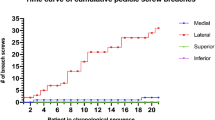Abstract
Purpose
Many authors favor conservative treatment options in oligo-symptomatic non-dislocated cervical fractures. This is mainly because of adverse events, anesthesia times and blood loss associated with surgical treatment of these injuries. We, therefore, sought to minimize the invasiveness of the surgical treatment of simple cervical fractures using image-guidance and a percutaneous approach.
Methods
Iso-C3D-based image guidance was used to place unilateral lag screws and conventional screws in pedicles, isthmi and lateral masses C1–C6. The navigation reference marker array was attached to the Mayfield clamp avoiding any additional skin incisions. Drilling of the screws trajectories was performed using a high speed drill with diamond tip, minimizing the risk of dislocations of cervical vertebrae and/or bone fragments relative to the iso-C3D scan to which the navigation system was registered.
Results
Image-guided percutaneous placement of cervical pedicle, isthmic and lateral mass screws resulted in correct screw placement in all six cases (three hangman fractures, three odontoid fracture Anderson 2 in elderly patients and one C6 posttraumatic pedicular pseudoarthrosis). Average blood loss was 194 ml, total average operating time 106 min and average X-ray time 3.8 min (395 cGy/cm2) including iso-C3D imaging.
Conclusion
The technique presented here was found to be a feasible minimally invasive treatment option for uncomplicated cervical fractures. Besides to our best knowledge, we here present the first percutaneous implantation of lateral mass screws.



Similar content being viewed by others
References
Molinari WJ 3rd, Molinari RW, Khera OA, Gruhn WL (2013) Functional outcomes, morbidity, mortality, and fracture healing in 58 consecutive patients with geriatric odontoid fracture treated with cervical collar or posterior fusion. Global Spine J 3(1):21–32. doi:10.1055/s-0033-1337122
Pal D, Sell P, Grevitt M (2011) Type II odontoid fractures in the elderly: an evidence-based narrative review of management. Eur Spine J 20(2):195–204. doi:10.1007/s00586-010-1507-6
Marton E, Billeci D, Carteri A (2000) Therapeutic indications in upper cervical spine instability. Considerations on 58 cases. J Neurosurg Sci 44(4):192–202
Ferro FP, Borgo GD, Letaif OB, Cristante AF, Marcon RM, Lutaka AS (2012) Traumatic spondylolisthesis of the axis: epidemiology, management and outcome. Acta Ortop Bras 20(2):84–87. doi:10.1590/S1413-78522012000200005
Riew KD, Raich AL, Dettori JR, Heller JG (2013) Neck pain following cervical laminoplasty: does preservation of the C2 muscle attachments and/or C7 matter? Evid Based Spine Care J 4(1):42–53. doi:10.1055/s-0033-1341606
Schoenfeld AJ, Ochoa LM, Bader JO, Belmont PJ Jr (2011) Risk factors for immediate postoperative complications and mortality following spine surgery: a study of 3475 patients from the National Surgical Quality Improvement Program. J Bone Joint Surg Am 93(17):1577–1582. doi:10.2106/JBJS.J.01048
Kantelhardt SR, Martinez R, Baerwinkel S, Burger R, Giese A, Rohde V (2011) Perioperative course and accuracy of screw positioning in conventional, open robotic-guided and percutaneous robotic-guided, pedicle screw placement. Eur Spine J 20(6):860–868. doi:10.1007/s00586-011-1729-2
Celestre PC, Pazmiño PR, Mikhael MM, Wolf CF, Feldman LA, Lauryssen C, Wang JC (2012) Minimally invasive approaches to the cervical spine. Orthop Clin North Am 43(1):137–147. doi:10.1016/j.ocl.2011.08.007
ElMiligui Y, Koptan W, Emran I (2010) Transpedicular screw fixation for type II Hangman’s fracture: a motion preserving procedure. Eur Spine J 19(8):1299–1305. doi:10.1007/s00586-010-1401-2
Sugimoto Y, Ito Y, Shimokawa T, Shiozaki Y, Mazaki T (2010) Percutaneous screw fixation for traumatic spondylolisthesis of the axis using iso-C3D fluoroscopy-assisted navigation (case report). Minim Invasive Neurosurg 53(2):83–85. doi:10.1055/s-0030-1247503
Kantelhardt SR, Keric N, Giese A (2012) Management of C2 fractures using Iso-C(3D) guidance: a single institution’s experience. Acta Neurochir (Wien) 154(10):1781–1787. doi:10.1007/s00701-012-1443-9
Molinari R, Bessette M, Raich AL, Dettori JR, Molinari C (2014) Vertebral artery anomaly and injury in spinal surgery. Evid Based Spine Care J 5(1):16–27. doi:10.1055/s-0034-1366980
Eap C, Barresi L, Ohl X, Saddiki R, Mensa C, Madi K, Dehoux E (2010) Odontoid fractures anterior screw fixation: a continuous series of 36 cases. Orthop Traumatol Surg Res 96(7):748–752. doi:10.1016/j.otsr.2010.04.013
Tian W, Weng C, Liu B, Li Q, Hu L, Li ZY, Liu YJ, Sun YZ (2012) Posterior fixation and fusion of unstable Hangman’s fracture by using intraoperative three-dimensional fluoroscopy-based navigation. Eur Spine J 21(5):863–871. doi:10.1007/s00586-011-2085-y
Yoshida G, Kanemura T, Ishikawa Y (2012) Percutaneous pedicle screw fixation of a Hangman’s fracture using intraoperative, full rotation, three-dimensional image (O-arm)-based navigation: a technical case report. Asian Spine J 6(3):194–198. doi:10.4184/asj.2012.6.3.194
Taghva A, Attenello FJ, Zada G, Khalessi AA, Hsieh PC (2013) Minimally invasive posterior atlantoaxial fusion: a cadaveric and clinical feasibility study. World Neurosurg 80(3–4):414–421. doi:10.1016/j.wneu.2012.01.054
Schaefer C, Begemann P, Fuhrhop I, Schroeder M, Viezens L, Wiesner L, Hansen-Algenstaedt N (2011) Percutaneous instrumentation of the cervical and cervico-thoracic spine using pedicle screws: preliminary clinical results and analysis of accuracy. Eur Spine J 20(6):977–985. doi:10.1007/s00586-011-1775-9
Acknowledgments
CT images were kindly provided by Prof. Müller-Forell, Institute of Neuroradiology, University Medical Center, Johannes Gutenberg-University Mainz, Germany.
Author information
Authors and Affiliations
Corresponding author
Ethics declarations
Conflict of interest
None.
Rights and permissions
About this article
Cite this article
Kantelhardt, S.R., Keric, N., Conrad, J. et al. Minimally invasive instrumentation of uncomplicated cervical fractures. Eur Spine J 25, 127–133 (2016). https://doi.org/10.1007/s00586-015-4194-5
Received:
Revised:
Accepted:
Published:
Issue Date:
DOI: https://doi.org/10.1007/s00586-015-4194-5




